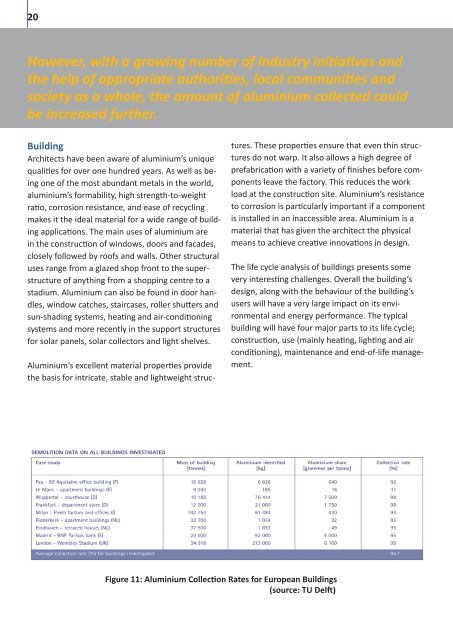Global Aluminium Recycling Brochure - Transport
Global Aluminium Recycling Brochure - Transport
Global Aluminium Recycling Brochure - Transport
Create successful ePaper yourself
Turn your PDF publications into a flip-book with our unique Google optimized e-Paper software.
20<br />
However, with a growing number of industry initiatives and<br />
the help of appropriate authorities, local communities and<br />
society as a whole, the amount of aluminium collected could<br />
be increased further.<br />
Building<br />
Architects have been aware of aluminium’s unique<br />
qualities for over one hundred years. As well as being<br />
one of the most abundant metals in the world,<br />
aluminium’s formability, high strength-to-weight<br />
ratio, corrosion resistance, and ease of recycling<br />
makes it the ideal material for a wide range of building<br />
applications. The main uses of aluminium are<br />
in the construction of windows, doors and facades,<br />
closely followed by roofs and walls. Other structural<br />
uses range from a glazed shop front to the superstructure<br />
of anything from a shopping centre to a<br />
stadium. <strong>Aluminium</strong> can also be found in door handles,<br />
window catches, staircases, roller shutters and<br />
sun-shading systems, heating and air-conditioning<br />
systems and more recently in the support structures<br />
for solar panels, solar collectors and light shelves.<br />
<strong>Aluminium</strong>’s excellent material properties provide<br />
the basis for intricate, stable and lightweight struc-<br />
tures. These properties ensure that even thin structures<br />
do not warp. It also allows a high degree of<br />
prefabrication with a variety of finishes before components<br />
leave the factory. This reduces the work<br />
load at the construction site. <strong>Aluminium</strong>’s resistance<br />
to corrosion is particularly important if a component<br />
is installed in an inaccessible area. <strong>Aluminium</strong> is a<br />
material that has given the architect the physical<br />
means to achieve creative innovations in design.<br />
The life cycle analysis of buildings presents some<br />
very interesting challenges. Overall the building’s<br />
design, along with the behaviour of the building’s<br />
users will have a very large impact on its environmental<br />
and energy performance. The typical<br />
building will have four major parts to its life cycle;<br />
construction, use (mainly heating, lighting and air<br />
conditioning), maintenance and end-of-life management.<br />
Figure 11: <strong>Aluminium</strong> Collection Rates for European Buildings<br />
(source: TU Delft)


